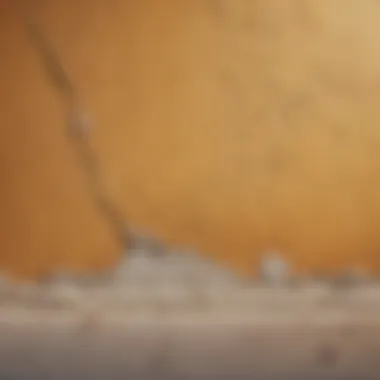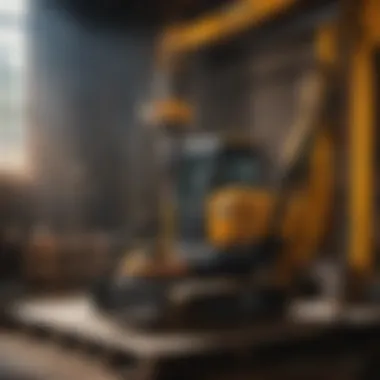Materials:
- Concrete mix: 20 bags (each bag weighs 60 lbs)
- Gravel: 1 cubic yard
- Wooden boards: 10 pieces of 2x4x8 lumber
- Rebar: 20 pieces of ⅜ inch diameter, each 6 feet long
- Plastic sheeting: 1 roll (20 feet x 100 feet)
DIY Steps:
- Clear the area where the foundation will be laid, ensuring it is level and free of debris and vegetation.
- Dig a trench according to the desired foundation dimensions, typically about 18 inches deep and 8 inches wide, using a shovel and level to maintain precision.
- Lay down a layer of gravel at the bottom of the trench, compacting it firmly to create a stable base.
- Construct wooden forms to outline the foundation shape, securing them in place with stakes and ensuring proper alignment and levelness.
- Place rebar within the form in a grid pattern for reinforcement, ensuring they are adequately spaced and elevated from the bottom.
Technical Aspects:
- Tools: Shovel, level, wheelbarrow, concrete mixer, hammer
- Timing: Allow for a curing period of 7 days before proceeding with further construction to ensure the foundation's strength
- Critical techniques: Proper compaction of gravel, accurate placement of rebar, and precise leveling of forms are paramount for a solid foundation
DIY Project Process:


- Mix the concrete according to package instructions, ensuring a proper water-to-concrete ratio for optimal strength and consistency.
- Pour the concrete into the formwork, filling it evenly and avoiding air pockets by compacting and smoothing the surface.
- Cover the freshly poured concrete with plastic sheeting to regulate curing temperature and prevent moisture loss.
- Allow the concrete to cure undisturbed for the specified time, periodically wetting it to promote hydration and strength development.
Troubleshooting Tips:


- If the concrete begins to set too quickly, consider adding a retarder to prolong workability
- In case of uneven curing or cracking, cover the affected area with damp burlap to promote moisture retention and even strength development
Introduction


The importance of a solid foundation cannot be overstated. It is the bedrock on which the entire structure of a house rests, influencing its stability, safety, and longevity. By gaining insight into common foundation issues, homeowners equip themselves with the knowledge necessary to identify early warning signs and take preventive measures, ultimately safeguarding their most significant investment - their home.
Types of Common Foundation Problems
The topic of 'Types of Common Foundation Problems' is crucial in this article as it serves as the foundation (pun intended) for understanding the various issues that can arise in a home's foundation. By delving into the specific elements of common foundation problems, readers can grasp the seriousness of these issues and the implications they have on the structural integrity of a house. Identifying and addressing these problems early can prevent costly damages and ensure the longevity of the property. Readers will benefit from a detailed exploration of different types of foundation problems, gaining insights into the warning signs and possible solutions available.
Cracks in the Foundation
Foundation cracks are a common issue that homeowners face and can be indicative of underlying structural problems. Understanding the different types of cracks, such as vertical, horizontal, or stair-step cracks, is essential in diagnosing the severity of the issue. Cracks can occur due to various reasons, including soil settlement, hydrostatic pressure, or poor construction. It is vital to address these cracks promptly to prevent further damage to the foundation and the overall stability of the house.
Settlement Issues
Settlement issues encompass both
Differential Settlement
Discussing the unique aspect of Differential Settlement in the context of foundation problems is vital for comprehending the uneven shifting of the structure due to variations in soil compaction. Highlighting the key characteristic of how one part of the foundation settles lower than another helps readers grasp the significance of differential settlement in causing structural instability. By understanding the advantages and disadvantages of addressing this differential settlement, readers can make informed decisions to protect their home's foundation.
Uniform Settlement
Exploring the specific aspect of Uniform Settlement sheds light on how the entire foundation sinks at a consistent rate, leading to a more evenly distributed settling of the structure. Emphasizing the key characteristic of uniform settlement and why it is a prevalent issue in the context of foundation problems helps homeowners identify such occurrences in their own properties. Describing the advantages and disadvantages of dealing with uniform settlement provides readers with a comprehensive understanding of how to manage this type of settlement effectively.
Foundation Upheaval
Foundation upheaval entails the opposite of settlement, where the foundation moves upward instead of settling down. This can result from various factors such as expansive soil, tree roots, or poor drainage. Understanding the causes and implications of foundation upheaval is crucial in preventing structural damage and preserving the integrity of the house's foundation.
Sagging or Uneven Floors
Sagging or uneven floors indicate underlying foundation issues that require immediate attention. Whether caused by poor soil compaction, water damage, or structural deficiencies, these problems can escalate if left untreated. Identifying the root cause of sagging or uneven floors is essential in implementing appropriate repair solutions to rectify the issue and prevent further damage to the foundation.
Causes of Foundation Problems
The section on 'Causes of Foundation Problems' within this article serves as a crucial focal point in understanding how various factors can impact the stability and integrity of a home's foundation. By delving into the root causes behind foundation issues, homeowners can equip themselves with the knowledge needed to identify, address, and prevent these problems effectively.
Poor Soil Compaction
Poor soil compaction emerges as a significant contributor to foundation problems, warranting thoughtful consideration. When soil beneath a foundation is improperly compacted during construction or becomes unsettled over time, it can lead to shifting, settlement, or upheaval of the foundation. This can manifest as cracks, uneven floors, or other structural issues within the home.
Excessive Moisture
Excessive moisture poses another critical threat to foundation stability, necessitating attention to mitigate potential risks. When soil around the foundation retains excess water due to poor drainage, it exerts pressure on the foundation walls, causing them to bow or crack. Moreover, high moisture levels can weaken the soil, leading to settlement and other detrimental consequences.
Tree Roots
The presence of tree roots near a foundation introduces a unique set of challenges that can compromise its integrity if not managed effectively. As trees seek water sources, their roots can extend beneath the foundation, extracting moisture from the soil and causing it to shrink. This process, known as desiccation, can result in soil movement and subsequent foundation issues, emphasizing the need for strategic tree management techniques.
Plumbing Leaks
Undetected plumbing leaks can silently wreak havoc on a home's foundation, underscoring the importance of vigilance in maintenance. Continuous water leakage from pipes can saturate the soil beneath the foundation, leading to erosion and destabilization. This gradual process can weaken the foundation's support system, ultimately manifesting as cracks, shifts, or structural distress.
Signs of Foundation Problems
In the realm of foundational integrity, recognizing early signs of potential problems is crucial. This section serves as a beacon to homeowners, shedding light on indicators that warrant attention to prevent further structural complications. By understanding and promptly addressing these signs, individuals can mitigate potential risks and uphold the stability of their abode.
Interior Signs
Ceiling Cracks
Ceiling cracks, a prevalent interior manifestation of foundational issues, signify underlying structural stress. By delving into the specificity of ceiling cracks, homeowners can grasp their significance in detecting potential foundational concerns. These cracks often serve as visible cues, indicating possible shifting or settling within the foundation. Their prominence in this article underscores their role as key indicators of foundational distress. Despite their alarming nature, ceiling cracks play a crucial role in alerting occupants to possible structural irregularities, prompting timely intervention to avert worsening conditions.
Sticking Doors or Windows
Sticking doors or windows present another interior sign that can signal foundational inadequacies. This subsection illuminates the pivotal contribution of such occurrences to the broader theme of foundation problems. The sticking of doors or windows can signify foundational shifts, creating functional impediments and aesthetic discrepancies. By elucidating the unique nature of this issue within the context of this article, readers gain insights into its significance in identifying potential structural issues. Understanding the advantages and disadvantages of this indicator aids homeowners in making informed decisions regarding necessary remedial actions.
Exterior Signs
Sloping Floors
The presence of sloping floors in a residential structure is a tangible exterior sign indicative of foundational challenges. Exploring the intricacies of sloping floors within this article underscores their substantive relevance in the realm of foundation issues. Sloping floors not only pose aesthetic concerns but also hint at structural imbalances that necessitate prompt attention. By outlining the unique features and implications of sloping floors in this narrative, homeowners can grasp the gravity of this outward manifestation of foundational distress.
Cracks in Exterior Bricks
Cracks in exterior bricks serve as visual cues that emphasize potential foundation complications within a home. This section dissects the specific characteristics of such cracks and their significance in the overarching discussion on foundation problems. The prevalence of cracks in exterior bricks underscores their importance as telltale signs of underlying structural issues. By elucidating the advantages and disadvantages of this outward indicator, readers can gain a comprehensive understanding of the implications and requisite actions associated with addressing such concerns.
Prevention and Solutions
Prevention and Solutions play a crucial role in maintaining a solid foundation for your home. By addressing potential issues early on, you can prevent costly damages and ensure the structural integrity of your property. Proper maintenance and proactive measures can significantly extend the lifespan of your foundation, providing long-term stability and peace of mind. Understanding the importance of regular inspections and implementing effective solutions can save homeowners time, money, and stress.
Proper Drainage
Proper drainage is essential for preventing water buildup around the foundation, which can lead to erosion and structural damage. Implementing adequate drainage systems, such as downspouts and French drains, directs water away from the foundation, preventing issues like soil saturation and hydrostatic pressure. Ensuring proper grading and maintenance of drainage systems is a crucial aspect of foundation maintenance to protect against moisture-related problems.
Foundation Repair Techniques
When facing foundation issues, repair techniques like slabjacking and piering provide effective solutions to stabilize and level the foundation.
Slabjacking
Slabjacking is a process that involves injecting a specialized material, such as grout or polyurethane foam, beneath a sunken concrete slab to raise it back to its original position. This technique is ideal for addressing settlement issues and correcting uneven floors. One key advantage of slabjacking is its cost-effectiveness compared to traditional replacement methods, making it a popular choice for homeowners looking to restore their foundation without extensive excavation.
Piering
Piering involves installing robust steel or concrete piers under the foundation to provide additional support and lift areas affected by settlement. This method is effective in stabilizing the foundation and preventing further structural damage. Its versatility allows for targeted reinforcement in specific problem areas, offering a tailored solution to varying foundation issues. While piering can be more costly than slabjacking, its durability and long-term benefits make it a valuable investment in securing the structural integrity of a home.
Tree Management
Proximity to trees can impact the health of a foundation due to root expansion and moisture absorption. Implementing proper tree management practices, such as maintaining adequate distance between trees and the foundation, regular pruning, and root barriers, can mitigate the risk of foundation damage. By addressing potential tree-related issues proactively, homeowners can protect their foundation from structural compromise.
Regular Inspections
Regular inspections are vital for identifying early signs of foundation problems and implementing timely repairs. By scheduling annual inspections with a qualified foundation specialist, homeowners can detect issues like cracks, uneven floors, or moisture problems before they escalate. Early intervention through regular inspections can prevent extensive damage, preserve the structural integrity of the foundation, and ensure the long-term stability of the home.





